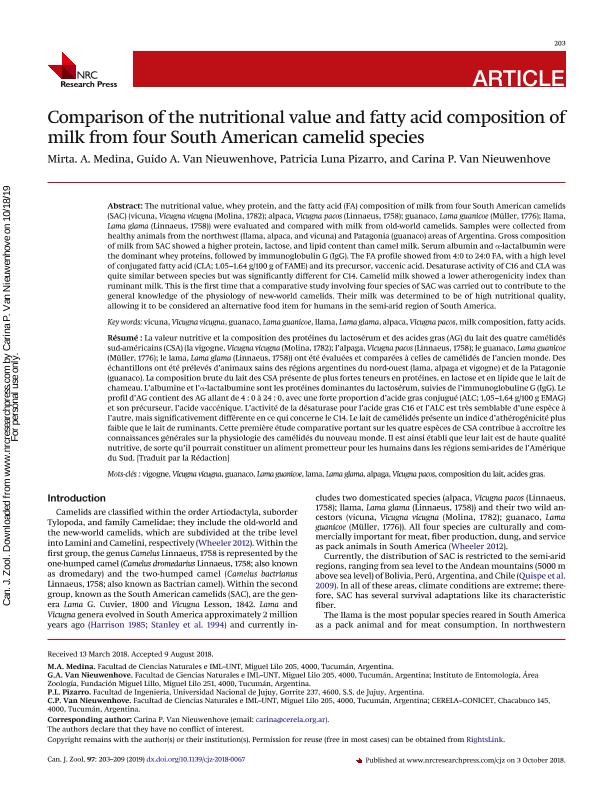Artículo
Comparison of the nutritional and fatty acid composition of the milk of four South American camelid species
Medina, Mirta Asunción; Van Nieuwenhove, Guido Alejandro ; Luna Pizarro, Patricia del Carmen; Van Nieuwenhove, Carina Paola
; Luna Pizarro, Patricia del Carmen; Van Nieuwenhove, Carina Paola
 ; Luna Pizarro, Patricia del Carmen; Van Nieuwenhove, Carina Paola
; Luna Pizarro, Patricia del Carmen; Van Nieuwenhove, Carina Paola
Fecha de publicación:
08/2018
Editorial:
National Research Council Canada-NRC Research Press
Revista:
Canadian Journal of Zoology
ISSN:
0008-4301
Idioma:
Inglés
Tipo de recurso:
Artículo publicado
Clasificación temática:
Resumen
The nutritional value, whey protein and the fatty acid composition of the four South American Camelid's milk, vicuna (Vicugna vicugna), alpaca (Vicugna pacos), guanaco (Lama guanicoe) and llama (Lama glama) were evaluated and compared to old-world camelids. Samples were collected from healthy animals from the Northwest (llama, alpaca and vicuna) and Patagonia (guanaco) areas of Argentina. Milk gross composition of SAC showed a higher protein, lactose and lipid content than camel milk. Serum albumin and -lactalbumin were the dominant whey proteins, followed by IgG immunoglobulin. The fatty acid profile showed from 4:0 to 24:0 fatty acids, with a high level of conjugated fatty acid (CLA, 1.05-1.64 g/100 g FAME) and its precursor, vaccenic acid. Desaturase activity for C16 and CLA were quite similar between species, but significantly different for C14. Camelid milk showed a lower atherogenic index than ruminant milk. By the first time, a comparative study about the four species of South American camelid was carried out, contributing to the general knowledge of the physiology of new-world camelids. High nutritional quality was determined in the milk, allowing to be considered as a promising alternative food for humans in semi-arid region of South America.
Palabras clave:
MILK COMPOSITION
,
FATTY ACIDS
,
VICUÑA
,
ALPACA
,
GUANACO
,
LLAMA
Archivos asociados
Licencia
Identificadores
Colecciones
Articulos(CERELA)
Articulos de CENTRO DE REFERENCIA PARA LACTOBACILOS (I)
Articulos de CENTRO DE REFERENCIA PARA LACTOBACILOS (I)
Citación
Medina, Mirta Asunción; Van Nieuwenhove, Guido Alejandro; Luna Pizarro, Patricia del Carmen; Van Nieuwenhove, Carina Paola; Comparison of the nutritional and fatty acid composition of the milk of four South American camelid species; National Research Council Canada-NRC Research Press; Canadian Journal of Zoology; 97; 3; 8-2018; 203-209
Compartir
Altmétricas



